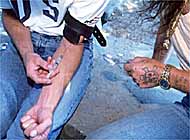
Government-sponsored heroin programme: last resort for worst cases

Switzerland's federal health authority considers its controversial heroin prescription programme a success. Now it wants health insurers to pay to its costs.
The number of places open to addicts who can enter the federal government’s heroin prescription programme has risen to 1,200. The figure represents an increase of 400 from two years ago when the programme was still considered a scientific experiment.
The figure emerged from the annual report of the Swiss Federal Office of Public Health (SFOPH) published on Friday. “The transition from experiment to a fully implemented programme lies behind us”, said Ueli Locher, the authority’s deputy director responsible for the programme.
Debate over the programme, during which the SFOPH was brandished “the country’s biggest drug dealer” by critics, was acrimonious until the issue was settled in a referendum by a narrow majority in favour of the programme in June last year.
The government also faced harsh criticism abroad, especially by to United Nations bodies, the World Health Organisation (WHO) and the International Narcotics Control Board (INCB) in Vienna.
That criticism had now subsided, Locher said in an interview with swissinfo. “International bodies have come to realise that we are not being irresponsible, but that the heroin prescription programme is only the last element in a whole system of treatments, and that we administer it very professionally.”
Since its inception, the programme has been considered an international model. The Netherlands recently started an experiment similar to Switzerland’s, Germany and Spain will begin prescribing heroin in 2001. Similar research projects are planned in France, Italy, the US and Canada.
Overall, 20,000 drug addicts are undergoing different types of drug therapy in Switzerland, according to the SFOPH report. Considering the size of Switzerland, the figure is estimated to be the highest in the world.
But of those treated, only 5 to 6 per cent are in the heroin prescription programme, “a figure often forgotten in an emotional debate”, says Locher.
Patients have to fulfil a series of conditions to be admitted to the programme. They have to be at least 18 years old and must have undergone at least two alternative therapies without success.
A high proportion of participants are suffering from severe psychological and social deficiencies, and many are multiple drug takers, a condition known to hamper the chances of ultimate success – abstention.
The debate over state-administered heroin heated up again this year over the question of financing. The SFOPH wants health insurance companies to pay for the treatment, which costs an average SFr18,000 per patient.
The SFOPH argues that health insurers have paid for similar treatments with Methadone, a heroin substitute, for many years. But health insurers are opposed to the government proposal on grounds that the treatment of drug addicts is not a medical, but a social measure.
With estimated overall costs of SFr15 million annually, the heroin prescription programme in question represents just over 0.1 per cent of overall health expenditure. The SFOPH concludes that the opposition to their proposal is motivated by attitudes rather than financial considerations.
“Drug addicts are still summarily and wrongly perceived as criminal, dirty and as outcasts,” Locher says.
The SFOPH says it wants to improve the effectiveness of the programme. An area singled out concerns multiple drug takers, a target group for which the programme was designed. According to the SFOPH, there was “much room for improvement” in the aim to get addicts to use “only” heroin – and not other hard drugs too.
Statistics show that roughly 50 per cent of all patients are undergoing treatment in the heroin prescription programme for four years. This high figure – or low success rate – should be seen in context, Locher says. “The programme is the last resort for the hardest cases.”
The current level of 1,200 participants in the heroin prescription programme is not expected to increase any further in the next 5 years according to the SFOPH.
by Markus Haefliger

In compliance with the JTI standards
More: SWI swissinfo.ch certified by the Journalism Trust Initiative




























You can find an overview of ongoing debates with our journalists here . Please join us!
If you want to start a conversation about a topic raised in this article or want to report factual errors, email us at english@swissinfo.ch.